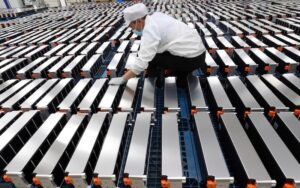>>REAL-TIME UPDATES IN THE WIRE. CLICK HERE<<<
China has been accelerating mining of domestic lithium resources amid surging lithium prices, and domestic lithium output in 2022 is expected to surge by 41.6% or by 200,000 tonnes from the previous year, according to estimates by Zhang Jiangfeng, deputy chairman of the lithium branch of China Nonferrous Metals Industry Association.
In the first half of the year, China’s domestic output of lithium carbonate totaled about 204,000 tonnes and output of lithium hydroxide reached 118,000 tonnes, according to the association. Combined, that’s equivalent to 308,000 tonnes of lithium carbonate equivalent (LCE).
In 2021, China’s produced about 480,000 tonnes of LCE and this year, lithium output will exceed 600,000 tonnes, according to Zhang.
As a key material for production of electric vehicle power batteries, development period of lithium resources is quite long and it’s difficult to meet the exponential growth of downstream demand from the new energy vehicle sector. The mismatch of supply and demand sent lithium prices to a record high of 500,000 yuan per tonne in March.
As of July 29, lithium carbonate prices stood at 472,500 yuan per tonne, surging by 62.9% from the start of the year.
China is a major processing hub of lithium salt, but it’s highly reliant on lithium import, with foreign dependence ratio up to 65% in 2021.
Bolstered by surging prices, China’s domestic lithium mining has been accelerating. According to Zhang, China is rich in lithium resources, but most of domestic reserves are with lower grade, making mining and processing more difficult and expensive.
The country’s lithium resources are mostly in Northwest China’s Qinghai province where annual lithium capacity exceeding 100,000 tonnes and 2021 output reaching 60,000 – 70,000 tonnes. The region’s lithium output is expected to increase by 20,000 – 30,000 tonnes this year, said Zhang.
Lithium resources in China’s Tibet region mostly have higher grade and in larger volume, but due to high altitude and fragile ecological environment, mining are restricted in the region, he said.
In May this year, Qinghai Salt Lake Industry Co.,Ltd, based in Qinghai, said it raised 7.08 billion yuan to build a lithium salt project with annual capacity of 40,000 tonnes. The construction will take two years and on completion, the company’s total capacity will double to 700,000 tonnes.
In addition, Zhang estimated that lithium output in Yichun, Central China’s Jiangi province, is expected to increase by 300,000 – 400,000 tonnes this year.
During the 14th Five Year Period (2021 – 2025), lithium demand in China and around the world will increased sharply and global lithium output and consumption will grow by around 30% a year, said Zhang, adding that demand from new energy and energy storage industries will increase continuously.
According to data from the China Association of Automobile Manufacturers, China sold 2.6 million units of new energy vehicles in the first half of the year, surging 120% from a year earlier.
Chen Shihua, secretary general of the association, said that the CAAM is confident that the full-year NEV sales in 2022 will exceed 5 million units, rising by 42% from the previous year.

